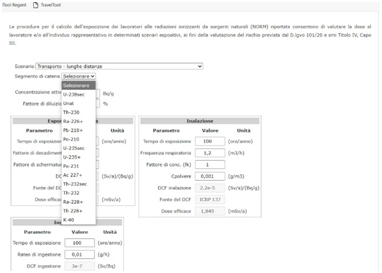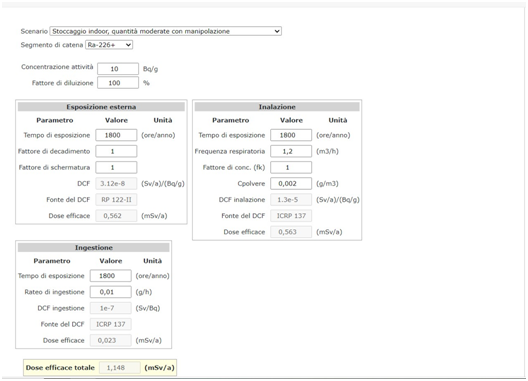User Guide to the use of the Dose Calculator
to assess exposure from NORM related activities.
The following procedure for calculating exposure to ionizing radiation from NORM allows for assessments of dose to workers and/or representative person in specific exposure scenarios in accordance with the risk assessment required by the Italian law (D. Lgs. 101/2020). To calculate the dose to the worker, the first step is to select the exposure scenario of interest. The “Dose Calculator” contains a drop-down menu with the following scenarios (see Fig. 1):
- Transport – Short distances
- Transport – Long distances
- Storage – Moderate quantities, indoors with processing
- Storage – Moderate quantities, indoors without processing
- Storage – Large quantities, outdoors with processing
- Storage – Large quantities, outdoors without processing
- Disposal of large amounts of NORM in a landfill
- Disposal of small amounts of NORM in a landfill
- Road construction
- Building construction (concrete walls containing NORM additives)
- Building construction (walls covered with gypsum wall plates)
Once the exposure scenario has been chosen (see Fig.1), a second drop-down menu allows the selection of the radionuclide or decay chain segment for which the dose must be calculated. In the blank field below, the corresponding value for the activity concentration (Bq/g) can be entered, as shown in Figure 2. The dilution factor, displayed at the bottom, indicates the percentage of NORM residues in the matrix under analysis. The calculator automatically provides a default value of 100%, but this can be modified by the user.
| Figure 1. Drop-down menu for the selection of the exposure scenario. | Figure 2. Drop-down menu for the selection of radionuclides or decay chain segments. |
 |
 |
In the lower section, based on the input parameters entered, the Dose Calculator provides the dose estimates for each exposure pathway (external exposure, ingestion, inhalation of dust) and the total effective dose (mSv/y).
These estimates depend on various parameters, some of which can be modified by the user:
- Parameters with white background are editable - they have a default value (usually from RP 122 – Part II), but it can be modified.
- Parameters with gray background are not editable – as the Dose Conversion Factors (DCF).
In the External Exposure box (Figure 3), the following parameters and default values are provided in order to calculate the dose:
- Exposure time (hours/year) with a default value of 1800 hours/year;
- Decay factor (unitless) with a default value of 1;
- Shielding factor (unitless) with a default value of 1;
- DCF (Sv/y)/(Bq/g): the Calculator provides the source (e.g., ICRP 137) and the corresponding non-editable value.
Figure 3 shows the contribution to the calculated dose in the conditions defined by the selected parameters, relative to the radionuclide or decay chain segment considered.
| Figure 3. Dose value for the different pathways and total effective dose for the considered scenario and radionuclide. |
 |
The dose estimated by the dose calculator, if evaluated by using the default values from RP 122 Part II, is usually very conservative. It is recommended to modify the parameters to conduct more realistic assessments, by applying actual values for some of them (e.g., exposure time) according to the scenario being analyzed.
In general, if the calculated effective dose is lower than the exemption/clearance levels required by the current legislation, the use of more accurate models might result in an even lower value. This is due to the fact that the Dose Calculator uses exposure scenarios defined from the publication RP 122 Part II, which are highly conservative for calculating DCF for external irradiation and does not consider any Personal Protective Equipment for the calculation of dose from inhalation or ingestion.
It should be noted that, if the estimated effective dose exceeds the exemption/clearance levels, in accordance with the graded approach established by the legislation, the use of more sophisticated models with more realistic data is allowed.







